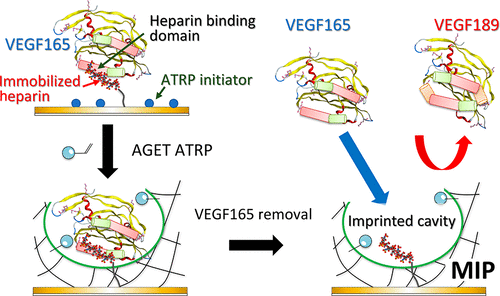Our official English website, www.x-mol.net, welcomes your
feedback! (Note: you will need to create a separate account there.)
Molecularly Imprinted Nanocavities Capable of Ligand-Binding Domain and Size/Shape Recognition for Selective Discrimination of Vascular Endothelial Growth Factor Isoforms
ACS Sensors ( IF 8.2 ) Pub Date : 2018-02-14 00:00:00 , DOI: 10.1021/acssensors.7b00622 Yuri Kamon 1 , Toshifumi Takeuchi 1
ACS Sensors ( IF 8.2 ) Pub Date : 2018-02-14 00:00:00 , DOI: 10.1021/acssensors.7b00622 Yuri Kamon 1 , Toshifumi Takeuchi 1
Affiliation

|
Vascular endothelial growth factor 165 (VEGF165) is known to be predominantly expressed in the first stage of vascularization; therefore, the detection of VEGF165 is important in the stage diagnosis of cancers. Molecularly imprinted nanocavities, capable of the selective discrimination of VEGF165 from other VEGF isoforms, were prepared by surface-initiated atom transfer radical polymerization. VEGF165 was immobilized on a gold-coated glass substrate by anchored heparin moieties, where the immobilized heparin was able to capture VEGF165 by binding with the heparin-binding domain (HBD) on VEGF165. Molecular imprinting was conducted on the immobilized VEGF165 by using methacrylic acid (MAA) as a functional monomer to interact with basic amino acids outside of the HBD of VEGF165 by electrostatic interaction. After the removal of VEGF165 from the obtained polymer thin layer (ca. 7 nm), VEGF165-imprinted nanocavities remained, in which the heparin moiety and MAA residues were located in suitable positions for VEGF165 recognition. The molecularly imprinted polymer (MIP) thin layer showed a binding affinity for VEGF165 (dissociation constant: 3.4 nM) that was ten times higher than that of the substrate before polymerization (heparin-immobilized substrate). A much lower binding affinity for VEGF121, which contains no heparin-binding domain, was observed. Moreover, the MIP thin layer distinguished VEGF165 from VEGF189, which possesses a larger molecular size than VEGF165, an amino acid sequence homology of 87%, and contains HBDs, whereas the heparin-immobilized substrate showed almost no selectivity. These results suggested that the heparin moiety within the nanocavity provided HBD selectivity and the polymer matrix composed of the molecularly imprinted nanocavity provided size/shape selectivity, which resulted in the highly selective discrimination of VEGF isoforms.
中文翻译:

分子印迹的纳米腔能够配体结合域和大小/形状识别的血管内皮生长因子同工型的选择性区分。
已知血管内皮生长因子165(VEGF165)主要在血管形成的第一阶段表达;血管内皮生长因子165(VEGF165)主要在血管形成的第一阶段表达。因此,VEGF165的检测在癌症的阶段诊断中很重要。通过表面引发的原子转移自由基聚合反应制备了分子印迹的纳米腔,该腔可选择性区分VEGF165和其他VEGF亚型。VEGF165通过锚定的肝素部分固定在镀金玻璃基板上,其中固定的肝素能够通过与VEGF165上的肝素结合域(HBD)结合来捕获VEGF165。通过使用甲基丙烯酸(MAA)作为功能性单体,通过静电相互作用与VEGF165的HBD以外的碱性氨基酸相互作用,对固定的VEGF165进行分子印迹。从获得的聚合物薄层(约7 nm)中除去VEGF165后,保留了VEGF165印迹的纳米腔,其中肝素部分和MAA残基位于适合VEGF165识别的位置。分子印迹聚合物(MIP)薄层显示出对VEGF165的结合亲和力(解离常数:3.4 nM),比聚合前的底物(固定有肝素的底物)高十倍。观察到对不含肝素结合域的VEGF121的结合亲和力低得多。此外,MIP薄层将VEGF165与VEGF189区别开来,后者的分子大小比VEGF165大,氨基酸序列同源性为87%,并含有HBD,而固定有肝素的底物几乎没有选择性。
更新日期:2018-02-14
中文翻译:

分子印迹的纳米腔能够配体结合域和大小/形状识别的血管内皮生长因子同工型的选择性区分。
已知血管内皮生长因子165(VEGF165)主要在血管形成的第一阶段表达;血管内皮生长因子165(VEGF165)主要在血管形成的第一阶段表达。因此,VEGF165的检测在癌症的阶段诊断中很重要。通过表面引发的原子转移自由基聚合反应制备了分子印迹的纳米腔,该腔可选择性区分VEGF165和其他VEGF亚型。VEGF165通过锚定的肝素部分固定在镀金玻璃基板上,其中固定的肝素能够通过与VEGF165上的肝素结合域(HBD)结合来捕获VEGF165。通过使用甲基丙烯酸(MAA)作为功能性单体,通过静电相互作用与VEGF165的HBD以外的碱性氨基酸相互作用,对固定的VEGF165进行分子印迹。从获得的聚合物薄层(约7 nm)中除去VEGF165后,保留了VEGF165印迹的纳米腔,其中肝素部分和MAA残基位于适合VEGF165识别的位置。分子印迹聚合物(MIP)薄层显示出对VEGF165的结合亲和力(解离常数:3.4 nM),比聚合前的底物(固定有肝素的底物)高十倍。观察到对不含肝素结合域的VEGF121的结合亲和力低得多。此外,MIP薄层将VEGF165与VEGF189区别开来,后者的分子大小比VEGF165大,氨基酸序列同源性为87%,并含有HBD,而固定有肝素的底物几乎没有选择性。











































 京公网安备 11010802027423号
京公网安备 11010802027423号